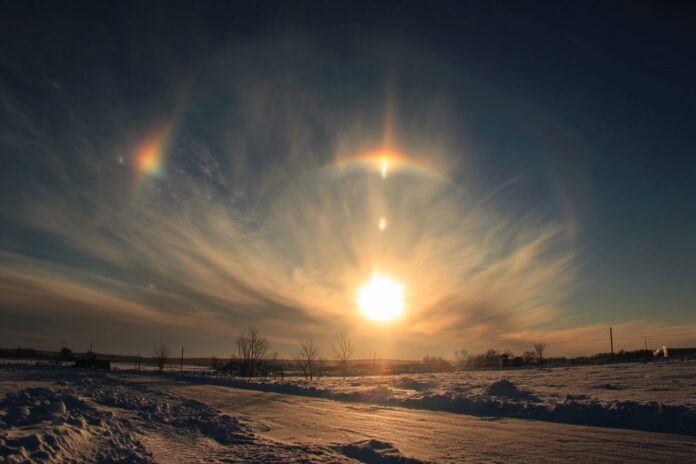The Universal Language of Atmospheric Light
Every so often, our skies delight us with flashes of beauty—sun dogs, vibrant rainbows, and spellbinding glories. Most importantly, these luminous phenomena serve as a universal language of nature, transcending cultural boundaries and scientific disciplines. They not only captivate the human imagination but also offer profound insights into the atmospheric and optical processes occurring both on Earth and beyond.
Because these celestial events result from the interplay of light and an array of atmospheric particles, they invite us to ponder our place in the cosmos. Therefore, when we witness these majestic displays, we are not merely spectators, but participants in an age-old cosmic ballet that connects our world to the broader universe. With each glimmer and glow, the sky speaks in bursts of radiant poetry.
What Are Sun Dogs, Rainbows, and Glories?
Sun dogs, also known as parhelia or mock suns, typically appear as colorful patches flanking the actual sun, each positioned about 22° from it. These halos are produced by the refraction of sunlight through ice crystals floating high in the troposphere. When the sun is low on the horizon, optimal atmospheric conditions amplify this effect, producing brilliant, almost ethereal lights as noted on Wikipedia. Most importantly, the beauty of sun dogs lies in their ephemeral nature, making each sighting a unique event.
Because rainbows arise from sunlight refracting and reflecting within raindrops, they are arguably the most familiar of these phenomena. They form spectacular, arching bands of color that enchant onlookers after a light rain. Besides that, glories present a rarer spectacle. Viewed from aircraft or lofty mountain peaks, glories appear as concentric rings surrounding the shadow of the observer on clouds, adding an extra dimension of mystery to our understanding of light.
The Science Behind Atmospheric Optics
Scientific exploration reveals that the magic behind sun dogs, rainbows, and glories is rooted in the behavior of light itself. Because sunlight interacts differently with ice crystals and water droplets, distinct patterns emerge. For instance, sun dogs result from hexagonal ice crystals that bend sunlight at precise angles, creating a pair of brilliant images beside the sun. Most importantly, understanding these mechanisms enhances our grasp of atmospheric physics.
Therefore, while rainbows form when water droplets act as tiny prisms, glories require even smaller droplets to create a nearly perfect, circular halo. In many cases, the presence of additional arcs and halos accompanies these primary phenomena, further enriching the visual tapestry of our skies. Experts and enthusiasts alike rely on these scientifically significant displays to better understand weather patterns and the natural behavior of light, as discussed in detail on Jim Block Photo.
Alien Worlds and the Possibility of Celestial Light Shows
Intriguingly, recent astronomical research invites us to consider that these optical phenomena may not be exclusive to Earth. A study leveraging data from the James Webb Space Telescope has suggested that planets such as WASP-17b could exhibit dazzling displays akin to Earth’s sun dogs. Because strong winds on these distant worlds potentially align exotic crystal formations, similar halos of light may be produced, offering a glimpse into alien atmospheric conditions. Most importantly, these revelations encourage a rethinking of what constitutes a beautiful sky in the context of an ever-expanding universe, as highlighted on Space.com.
Moreover, rainbows and glories, which depend on specific particle sizes and optical angles, could also manifest on exoplanets with the right atmospheric cocktail. Because each planet’s unique conditions would tailor these light phenomena differently, studying them could offer clues about an alien world’s atmospheric composition. Therefore, as illustrated by intriguing visuals on YouTube, these events not only decorate the skies but also serve as vibrant indicators of underlying planetary processes.
Observing These Enchanting Phenomena
In addition to their scientific significance, sun dogs, rainbows, and glories provide recreational and educational opportunities for sky-watchers around the globe. Because these atmospheric light shows are accessible with the naked eye, amateur astronomers and photographers alike have long been inspired to capture their fleeting beauty. Most importantly, observing these events invites one to pause and appreciate the natural artistry at work.
Besides that, participation in organized sky-watching events and photography contests can provide an excellent platform for learning. Detailed guides and tutorials are available on various websites, enabling enthusiasts to understand the underlying science and improve their skills in capturing these phenomena. Such community endeavors foster a deeper connection with nature by encouraging people to explore, share, and celebrate our planet’s atmospheric wonders.
Why Understanding Alien Atmospheric Phenomena Matters
Because observing these celestial effects provides more than just a visual treat, they are also valuable scientific tools. Studying light phenomena in extraterrestrial atmospheres can offer clues about the particle size, composition, and dynamics of those alien skies. Most importantly, such investigations broaden our knowledge of how light interacts with different atmospheres across the universe.
Therefore, detailed optical observations can unravel mysteries regarding planetary weather systems and climatic conditions that might be vastly different from Earth’s. Besides that, these studies push forward both the fields of atmospheric science and astrophysics, fostering interdisciplinary research that spans from laboratory experiments to space missions.
Final Thoughts: A Universe Illuminated by Light
In summary, sun dogs, rainbows, and glories are not simply fleeting spectacles in our skies. They are profound reminders of the intricate dance between light and matter that occurs on Earth and possibly across the cosmos. Most importantly, these natural phenomena invite us to expand our horizons and imagine the diverse beauty of alien skies.
Because our tools for exploring the universe are continually advancing, we find ourselves on the threshold of witnessing light shows in places once thought unreachable. Therefore, every time you gaze upward at a brilliant sun dog or an arc of a rainbow, remember that you are witnessing a phenomenon that could be mirrored on distant planets, uniting us all under the common spectacle of a beautifully illuminated universe.



